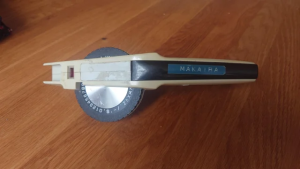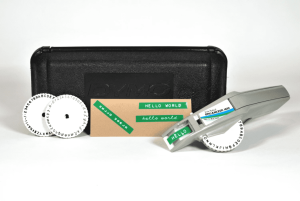Over the course of centuries, label makers have seen a remarkable evolution, going from crude hand-carved labels to sophisticated digital equipment. These essential tools have transformed manufacturing, retail, and organization. Let’s travel through the lengthy history of label makers, looking at their founding principles, significant inventions, and global industry effects.
Ancient Label Makers: The Origin of Organization
The idea of labeling was present in ancient societies long before contemporary technologies. To identify objects and indicate ownership, people employed rudimentary techniques. The oldest methods for creating labels required etching or carving symbols into materials such as stone, clay, or wood. These labels performed an important function—organizing and identifying items—even if they were very different from the slick, personalized options available today.

Often, these early labels were fastened to products by strings or rudimentary adhesives. They were mostly employed in trade, where it was important to determine who owned or what was inside of products. Even though it was labor-intensive and had limitations, this system served as a model for more advanced labeling systems that are in use today.
The Emergence of Industrial Label Manufacturers: Transforming Manufacturing
When the Industrial Revolution arrived, the labeling industry underwent a significant transformation. Efficient systems for marking products, tools, and containers were necessary for mass production. As a result, the first industrial label manufacturers were created. These were crude devices, but they were far more effective than manual labor.
These early devices were frequently operated by hand and stamped information onto labels using wooden or metal types that could be changed out. The result was significant: producers could now swiftly and precisely identify big quantities of goods, which decreased human error. Around this time, automated labeling systems were used, streamlining production procedures and laying the groundwork for contemporary industry norms.
Technological Advances in Label Production: The Digital Transition
Label-making technology developed along with industry and technological advancements. The introduction of digital label printers was one of the biggest innovations. In contrast to the labor-intensive, hand-operated processes of the past, digital printers provided accuracy, speed, and personalization.
With the use of methods like inkjet or laser printing, digital label printers enable companies to generate full-color, high-quality labels. Digital printing provides countless customization options, including different forms, sizes, and materials, for both straightforward barcodes and intricate designs. This invention has completely changed the game for sectors where accurate and efficient labeling is essential, like manufacturing and retail.
Furthermore, label design software became readily accessible, enabling individuals to produce labels with a professional appearance without the need for specialist knowledge. These solutions make it easier than ever to connect labels with branding goals by providing layouts, typefaces, and graphic possibilities. Productivity has been further increased by features like database connectivity and barcode generation, which make it possible to track inventory and items easily.
Label Manufacturers’ Effects on Retail and Packaging

Retail and packaging have been greatly impacted by label manufacturers. Thanks to contemporary label manufacturers, you can now find aisles full of products with clean labels at any retail establishment. These labels contribute to brand identification and customer engagement in addition to providing necessary information.
Efficient labeling streamlines the shopping experience for customers by making things easier to find in retail settings. Item identification is guaranteed by neat, well-organized labels, which lowers confusion and raises consumer satisfaction. Furthermore, by being able to design personalized labels, merchants are able to improve their branding initiatives and make sure that labels match their visual identity.
Label manufacturers have increased accuracy and adherence to industry standards in packaging. Manufacturers are able to easily create comprehensive labels that contain safety guidelines, product details, and legal requirements. Since transparent labeling guarantees information about the contents and origins of products, consumer trust has increased as a result.
Industrial Revolution Label Makers: A Revolutionary Development
Label-making technology reached a turning point during the Industrial Revolution. The need for effective labeling systems increased as companies become increasingly mechanized. Simple machines called “label makers” were used in this era to imprint basic information on things like crates and containers.

These devices markedly increased productivity over handwritten labels—which were prone to mistakes. The application of uniform, readable labels in large quantities was made possible by industrial label makers, which decreased errors and improved the organization of items. This development was essential to the modernization of logistics and industrial operations.
Label Makers’ Development in the Digital Age
Label makers have experienced yet another change in the digital age. The manual label machines of the past are being replaced with faster, more efficient digital equipment due to the rise of computerized systems. Because a large portion of the process has been automated by these computerized label manufacturers, businesses can now produce labels with little to no human input.

The fusion of mobile and wireless technology has been one of the biggest developments of this century. These days, modern label makers can link to PCs, tablets, and cellphones, allowing real-time label printing from almost anywhere. Businesses in the retail, industrial, or logistics industries have found it easier to meet the quick-paced needs of the modern market thanks to this degree of convenience.
The Function of Label Manufacturers in Increasing Output
Label makers are essential tools for improving productivity and organization in today’s workplaces. These devices provide unparalleled versatility and effectiveness, whether it comes to marking documents and folders or setting up storage areas. With the help of contemporary label makers, users can personalize labels with different fonts, colors, and symbols to create an aesthetically pleasing and useful organizational system.

The greatest benefit? ability to save time. Workers no longer strain to maintain legibility across departments or have to handwrite labels. Instead, they may create polished labels that assist organize and streamline daily chores with a few clicks. Increased operational efficiency and cost savings are the results of this productivity increase in a variety of industries.
Conclusion: Label Makers’ Unstoppable Evolution
Label makers have advanced significantly, from the engraved stones of antiquity to the modern, sleek digital gadgets. These instruments have revolutionized entire sectors, bringing about unprecedented levels of productivity, organization, and efficiency that were unthinkable just a few decades ago. The future of label makers appears bright as long as technology keeps moving forward; possibilities such as AI-driven designs and smart label integration are only around the corner. Label manufacturers will undoubtedly continue to play a crucial role in maintaining personal and professional organization, ensuring that various industries remain productive and well-structured for many years to come.


